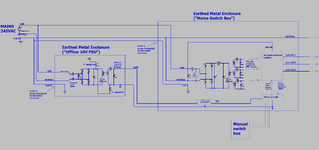cupoftea
Advanced Member level 6

What do you do when you have an
Offline SMPS in earthed metal enclosure but cant use Y caps.?
You cant use Y caps because of their AC current , which will trip the RCDs if too many connected Y caps overall.
Is it maybe you just connect the neutral Y cap, (obviously theres no current in that one) and hope that the current through the X2 caps gives it some connection to Line...so you get an overall Y cap effect?
Can you compensate by just using an enormous Common mode choke and hoping the "stray" y caps will act with that to combat the dreaded common mode noise?
We all know the dreaded common mode noise is the cause of all noise_ills in electronics.
Offline SMPS in earthed metal enclosure but cant use Y caps.?
You cant use Y caps because of their AC current , which will trip the RCDs if too many connected Y caps overall.
Is it maybe you just connect the neutral Y cap, (obviously theres no current in that one) and hope that the current through the X2 caps gives it some connection to Line...so you get an overall Y cap effect?
Can you compensate by just using an enormous Common mode choke and hoping the "stray" y caps will act with that to combat the dreaded common mode noise?
We all know the dreaded common mode noise is the cause of all noise_ills in electronics.

